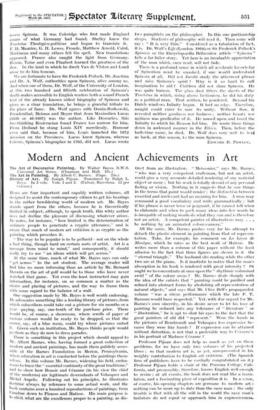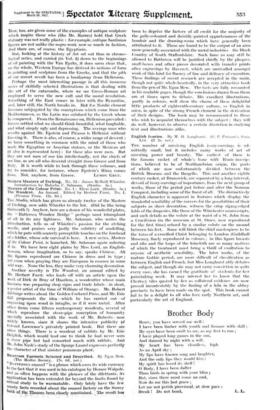Modern and Ancient Achievements in Art
History of Art. By Joseph Pijoan. Translated by Ralph. L.
Ilmer. are four important and capably written volumes, all designed to assist the contemporary citizen to get his bearings in the rather bewildering world of modern art. Mr. Bayes stands apart from the others, because he is theoretically limited in subject, although, to speak truth, this witty author (lees not decline the pleasure of discussing whatever arises. Ile notes, for instance, " how limited is the determination of ordinary people to penetrate a cryptic utterance," and is aware that much of modern art criticism is as cryptic as the painting which provokes it.
" The way to be popular is to be pellucid—not on the whole a had thing, though hard on certain sorts of artist. Art is a message from mind to mind," and consequently, it should really try to use " an idiom which will get across."
At the same time, much of what Mr. Bayes says can only " get across " to the art student. The average reader will find him no more informing than an article by Mr. Bernard Darwin on the art of golf would be to those who have never watched that game. • Yet even the least instructed may gain information, for instance, on so common a matter as the choice and placing of pictures, and the way to frame them with some regard to the balance of a wall.
One suggestion made by Mr. Bayes is well worth endorsing. lie advocates something like a lending library of pictures, from which subscribers could take out a picture for six months or a year—paying, say, one-tenth of the purchase price. There would be, of course, a showroom, where scrolls of paper of various colours would be ready to be dropped, so that the owner, say, of a blue room, could try where pictures suited it. Given such an institution, Mr. Bayes thinks people would go there as they do now to dress parades.
There is something in this project which should appeal to Mr. Albert Barnes, who, having formed a great collection of modern and ancient paintings, has made them publicly acces- sible at the Barnes Foundation in Merton, Pennsylvania, Where education in art is conducted before the paintings them- selves. In _this volume. Mr. Barnes, widening his field, endea- vours to trace the " essential continuity of the great traditions," and to show how Renoir and Cezanne (in his view the chief of the moderns) are legitimate descendants. of Velasquez and Michel Angelo. Following out his principles, he illustrates doctrine always by reference to some actual work, and the
hook contains ,over a hundred reproductions of paintings, from Cimabue down to Picasso and Matisse. His main purpose is
to elicit: what are the excellences proper to a painting, as dis-
Una from an illustration. " Meissonier," says Mr. Barnes, " who was a very competent craftsman, but not an artist, could give a very accurate detailed rendering of any material object or scene ; but his work is totally devoid of any personal feeling or vision. Nothing in it suggests that he saw things in the terms that paint would render : the distinction between essential and irrelevant had no meaning for him. A man may command a good vocabulary and write grammatically ; but if his phrase is never terse or poignant, if he cannot tell when to elaborate and when to pack many ideas into few words he is incapable of making words do what they can and is therefore not an artist. A competent painter of illustrations may . . . be nothing by an animated colour-camera."
All the same, Mr. Barnes pushes very far his attempt to detach the plastic element in painting from that of represen- tation. Take, for example, his comment on La Leon de Musique, which he rates as the best work of Matisse. Ile writes more than a column of this paper without the least allusion to the fact that three figures arc shown in it the " eternal triangle." The husband sits reading while the other two are at the piano. Is it inartistic to notice that the man's absorption in his book is rendered with great intensity ? Or ought we to concentrate at once upon the " rhythmic voluminal swirl " of the colour areas ? Mr. Barnes deals sharply with the idea of the cubists that " painting could be purified and refined into abstract forms by abolishing all representation of natural objects," and says that Mr. Clive Bell's propagandist volume " was a circus perforinance which the late P. '1'. Barnum would have respected." Yet, with due regard for Mr. Barnes's own sincerity, in his desire never to let .his love of painting be seduced into any tolerance of " literature " or " illustration," he is apt to shut his eyes to the fact that the great painters of old did " represent." Were the hands in the pictures of Rembrandt and Velasquez less expressive be- cause they were like bands ? If expression can be attained without distortion, is not that a preferable way to CCzarine's in his portrait of Madame Cezanne ?
Professor Pijoan does not help us much as yet on these problems, for we have only two volumes of his projected three ; so that modern art is, as yet, unrepresented in his weighty-contribution to English art criticism. (The Spanish firm of publishers have to be cordially congratulated on it.) Professor Pijoan holds a chair at the Pomona College, Cali- fornia, and presumably, therefore, knows English well enough to revise ; at all events, the book does not read like a trans- lation, and a fascinating piece of exposition it is. In a sense, of course, his opening chapters are germane to modern art : nothing can be more up• to date than the cave man : the only trouble is that with all the will in the -world the cave man's imitators do not equal or approach him in expressiveness. Here, too, are given some of the.examples of antique sculpture which Inspire those who (like Mr. Barnes) hold. that Greek
statuary was not really plastic : for example, antique Sardinian figures are not unlike the negro work now so much in fashion,. And there are, of course, the Egyptians.
But, looking at the history at Art set out thus in chrono- logical series, and carried (in Vol: 3) down to the beginnings of oil painting with the Van Eycks; it does seem clear that, on the whole, 'Western Europe has derived its notions of form in painting and sculpture froth the Greeks, and that the pith of our recent revolt has been a - breakaway from Hellenism.
Perhaps the most interesting passage in all this immense series of skilfully selected illustrations is that dealing with the art of the catacombs, where we see Greco-Roman art employed to serve the new cult and the moral revolution. Something of the East comes in later with the Byzantine. and, later still, the North breaks in. But it le Nordic element becomes subjugated by the conceptions mhich come from the Mediterranean. as the Latin was subdued by the Greek whom he conquered. From the Renaissance on, Hellenism prevailed : Greece settled what we should think beautiful, what laughable, and what simply ugly and depressing. The average man who revolts against Mr. Epstein and Picasso is Hellenist without knowing it. There is also, of course, a wider range of descent : we have something in common with the mind of those who made the Egyptian or Assyrian statues, or the Mexican art (it also is represented here) : for these also were men. But they are not men of our kin intellectually, not the chiefs of our line, as are all who descend straight from Greece and from Italy. It is worth while to look through these volumes, and try to consider, for instance, where Epstein's Rima comes
from. Not, anyhow, from Greece. LEMON GREY.























































 Previous page
Previous page